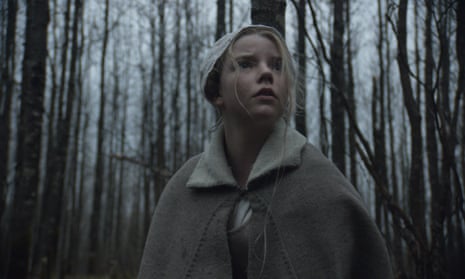“What went we out into this wilderness to find?” Subtitled A New England Folktale, writer-director Robert Eggers’s Sundance prize-winning feature debut is an atmospheric chiller rooted in the fertile soil of religious zealotry, social isolation and original sin. On the surface, it is the story of a puritanical 17th-century English family enduring an American nightmare, tormented by a wicked witch who steals their children and their souls. But beneath that surface lurks something more disturbing – a tale of God-fearing folk whose terrified belief in the twisted fantasies of folklore hides their own darker secrets.
We open with the beleaguered family leaving their New World community to live alone on the very edges of civilisation. As they depart, singing “I will confess…”, cinematographer Jarin Blaschke’s archaic framing – the taller, narrower 1.66:1 ratio – captures these lonely souls receding inexorably into alien lands (the film could equally well be entitled A Field Not in England).
The discordant strains of Mark Korven’s score, a superbly evocative symphony of nyckelharpa strings and eerie scrapes, give way to an image of prostrate prayer, as father William (Ralph Ineson) leads his brood in face-down worship on the outskirts of an imposing wood. It is into these woods that their youngest child will vanish, snatched by a spectral presence into a fairytale nightmare – an abyss of trees accompanied by a Ligeti-like wall of sound; a choir of (in)human horror.
What follows is a thematic mash-up of the European folk tales of the Brothers Grimm and Charles Perrault (the figures of Hansel and Gretel, Red Riding Hood and Sleeping Beauty loom large), the paranoid finger-pointing of Arthur Miller’s play The Crucible, the religious devotion of Dreyer’s Ordet and the historical detail of Aldous Huxley’s book The Devils of Loudun. “We will conquer this wilderness, it will not consume us!” insists William as the camera creeps repetitively toward the Twin Peaks-like woods, but the film tells another story – the story of a demonic goat named Black Phillip that whispers to the children, and of shape-shifting hares (one of several inevitable echoes of The Wicker Man) that call this fracturing family to damnation.
At first, Eggers favours the physical depiction of the family’s fear, a nightmarish early sequence of their child in the clutches of a haggard, ghoulish figure seeming to dispel any sense of ambiguity about the archetypal nature of this “evil”. Or does it? Despite this monstrous vision, it is still possible (and indeed preferable) to read The Witch as a story whose demons lurk largely within the mind. Just as the family are obsessed with the concept of sin (poor Caleb recounts his putrefaction by rote and anguishes about his lustfully hell-bound heart), so Eggers not so slyly suggests that such anxieties perversely invite horror into the home, where shadowy faces flicker in the firelight.
While the sounds of livestock and creaking gates blend with the wind to form Penderecki-esque night music, Kate Dickie’s bereaved, homesick mother Katherine personifies the down-to-earth derangement that feeds upon hunger, worry and loss. A dreamy sequence in which a raven pecks at her bloodied breast straddles the line between fantasy and reality, just as Caleb (Harvey Scrimshaw) emerges from his own guilty traumas with a poisoned apple in his mouth – extraordinary but not quite conclusive. Even when the narrative drifts into literal flights of folklorish fantasy, we should remember that what we see on the screen is by its very nature a trick of the light, a magic lantern display (or communal hallucination) rooted in the apparitions of the fairground seance. I would have preferred the omission of a coda that many will take (too?) literally, but even this is prefigured by a dramatic hiatus that causes us to question its “reality”. Or, at least, that’s how I chose to read it.
In the end, that is the greatest strength of The Witch – that the audience will see in it what they want to see, or believe. New England native Eggers has clearly researched his history in depth (for him, the devil is in the period detail) and lifts dialogue directly from contemporaneous diaries, letters and religious documents. From such research, startling images emerge: of William chopping wood like a man possessed; Katherine laying down in an open grave, Caleb convulsing in rapturous torment and youngsters Mercy and Jonas howling in synchronised hysteria. At the centre of it all is Anya Taylor-Joy’s brilliantly rendered Thomasin, the family’s eldest child within whose coming-of-age transformation (“She hath begat the sign of her womanhood”) the heart of the narrative resides. Perhaps this is all a fevered dream, an ergot-induced hallucination for which those rotting crops provide a deliberately ripe explanation. But through Thomasin’s eyes it takes on its own reality, a reality we experience through her devotion, her disavowal and, ultimately, her defiance.
While the poster for The Witch may conjure up memories of William Friedkin’s The Guardian, this owes nothing to that film’s hokey horrors.Eggers has cited Kubrick’s The Shining as influential, alongside Benjamin Christensen’s silent classic Häxan: Witchcraft Through the Ages and Ingmar Bergman’s Cries and Whispers. Others have compared The Witch to Jennifer Kent’s The Babadook and Tomas Alfredson’s Let the Right One In, although I found myself thinking more of Hans-Christian Schmid’s Requiem as a thematic companion piece.
Apparently, a long-planned Nosferatu remake is in the pipeline for Eggers, which we eagerly await. For the moment, in an age of cattle-prod scares, The Witch plants its pitchfork proudly in the more unsettling landscape of evocative, intelligent modern horror.

Comments (…)
Sign in or create your Guardian account to join the discussion